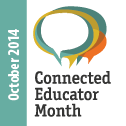 As Judy mentioned last week in her post, this month is Connected Educator Month. I was just reading this post from the Langwitches blog about the Four Big Ideas Around the Connected Educator. They identify these 4 Big Ideas as: Local Isolation, Gaining Perspective, Data Crowdsource Resources, and Model for Students. These four concepts or ideas definitely relate to the school librarian.
As Judy mentioned last week in her post, this month is Connected Educator Month. I was just reading this post from the Langwitches blog about the Four Big Ideas Around the Connected Educator. They identify these 4 Big Ideas as: Local Isolation, Gaining Perspective, Data Crowdsource Resources, and Model for Students. These four concepts or ideas definitely relate to the school librarian.
First is local isolation, being the only school librarian in the building definitely leads to isolation. Connecting with other school librarians, peers, and experts can provide a connection, a way to share, a support system, and a way to learn and grow as a reflective practitioner.
Gaining perspective is critical as we seek to teach our students to consider multiple points of view – to think and learn beyond their own four walls or zip code. Connecting with other educators through building and fostering your Personal Learning Network (PLN) provides a way to do this through providing different points of view, fresh ideas from new professionals, benefit of experience from those experienced school librarians, views from different cultures and locations across the world.
Take advantage of crowdsourcing and your personal learning network. Crowdsourcing “is the process of obtaining needed services, ideas, or content by soliciting contributions from a large group of people, and especially from an online community.” This goes way beyond networking in the traditional face-to-face sense! I experience the value of my PLN on a daily basis – I get resources for classes, I gather data for my research, I get help when I have a problem and tips on ways to do things more efficiently that save me time, and I collaborate on a global scale 24/7.
As we expect students “consider diverse and global perspective” and to “contribute to the exchange of ideas within the learning community” it is important that we model this for both students and teachers (AASL, 2007). We must use our PLNs for more than just our own professional growth – use them to to connect teachers to resources, peers, experts so that they can grow their own learning network and model for their students, in order to open up a world of learning opportunities for their students in their classrooms.
So make sure you are a connected educator and that the teachers in your school are too – get involved in Connected Educator Month!
References
American Association of School Librarians (AASL). (2007). Standards for the 21st-century learner. Chicago: American Library Association. Retrieved from http://www.ala.org/ala/aasl/aaslproftools/learningstandards/standards.cfm
Crowdsourcing. (n.d.). In Wikipedia. Retrieved from http://en.wikipedia.org/wiki/Crowdsourcing
